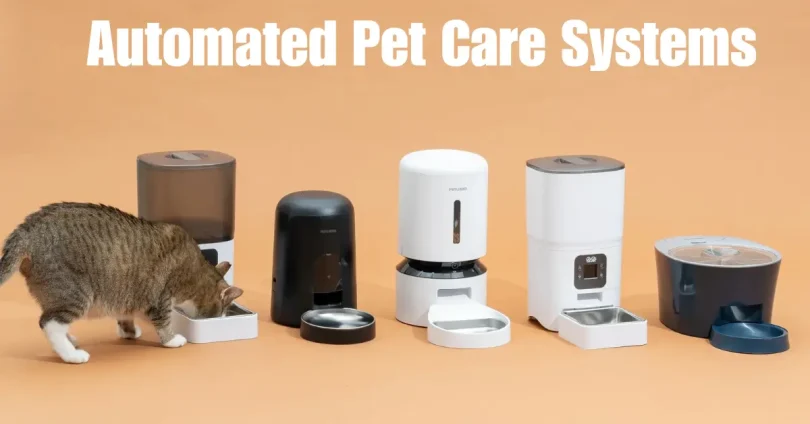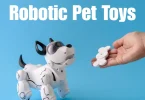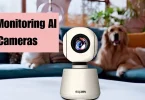Owning a pet is a rewarding experience, but it comes with responsibilities that require consistent time, attention, and care. Feeding, watering, exercise, health monitoring, and ensuring comfort can be challenging—especially for busy pet owners or those frequently away from home. Advances in technology have paved the way for automated pet care systems that help owners manage these tasks efficiently and effectively, enhancing the overall well-being of pets.
This article explores what automated pet care systems are, the technologies involved, their features and benefits, challenges, popular products, and future trends. If you want to ensure your furry (or not so furry) friend gets the best care possible with less hassle, this guide is for you.
What Are Automated Pet Care Systems?
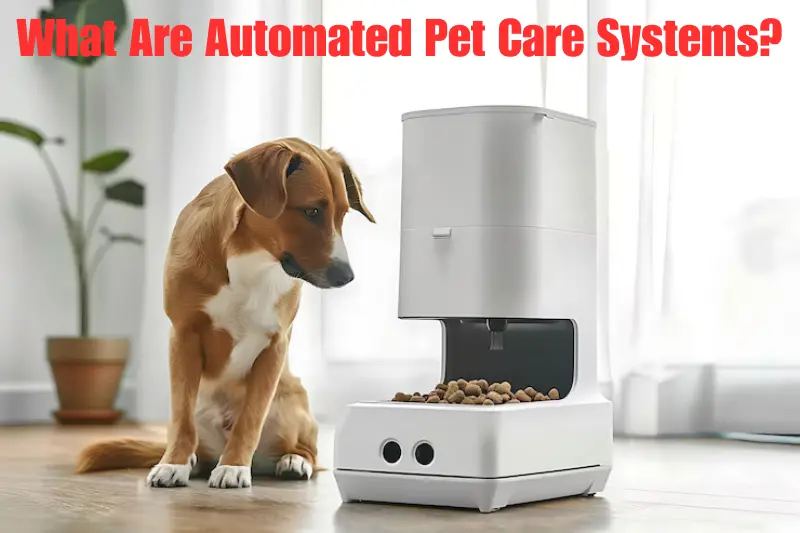
Automated pet care systems are integrated devices and software solutions designed to perform essential pet care tasks without requiring constant human supervision. These systems use smart technology—such as sensors, artificial intelligence (AI), IoT (Internet of Things), and mobile connectivity—to automate feeding, watering, health monitoring, waste management, playtime, and even environmental controls.
They are especially helpful for pet owners who are busy, travel often, or want to add an extra layer of safety and comfort for their pets.
Core Components of Automated Pet Care Systems
1. Automated Feeding Systems
Smart feeders are at the heart of many pet care automation setups. These devices:
- Scheduled feeding: Owners program specific times for feeding, ensuring pets eat at consistent intervals.
- Portion control: Feeders release precise amounts of food, which is crucial for maintaining a healthy weight and preventing overeating.
- Food storage: Many feeders keep dry food fresh by sealing it in airtight compartments.
- Remote operation: Using a smartphone app, owners can adjust feeding schedules or dispense extra meals remotely.
- Camera integration: Some feeders include built-in cameras to let owners watch their pets eat and interact with them via two-way audio.
- Multiple pet support: Advanced feeders can distinguish pets via RFID collars or microchips to feed each pet individually.
These features ensure pets never miss a meal, and diets are controlled, which is particularly important for pets on special feeding plans.
2. Automated Water Dispensers
Proper hydration is vital for pet health. Automated water dispensers:
- Maintain fresh water: By circulating or filtering water, these devices prevent stagnation and reduce bacterial growth.
- Refill alerts: Sensors detect water levels and notify owners or trigger automatic refills.
- Multiple pet usage: Designs accommodate the drinking habits of various pets, including cats, dogs, and even birds.
- Hygiene focus: Some models use UV sterilization to keep water pure.
Consistent access to clean water promotes hydration and reduces risks of urinary or kidney problems, common in pets.
3. Health Monitoring and Wellness Tracking
Health-monitoring technologies in automated pet care systems are revolutionizing preventive care. These include:
- Wearable devices: Collars or harnesses equipped with sensors track vital signs like heart rate, respiratory rate, activity levels, sleep patterns, and even stress indicators.
- Behavior analysis: AI algorithms detect changes in behavior or activity that might signal illness or discomfort.
- Medication reminders: Apps linked to these devices remind owners when to administer medications or schedule vet visits.
- Veterinary integration: Some systems share data directly with veterinarians for real-time health monitoring and remote consultations.
- GPS tracking: For pets that roam outdoors, GPS collars provide location tracking to prevent loss.
These health monitoring tools enable early detection of potential problems, improving treatment success rates.
4. Smart Litter Boxes and Waste Management
For cat owners, waste management is often a daily chore. Smart litter boxes:
- Automatic cleaning: After a cat uses the litter box, sensors trigger a cleaning cycle that sifts and separates waste into a sealed compartment.
- Odor control: Many models use carbon filters or sealed waste bins to minimize unpleasant smells.
- Waste alerts: Owners receive notifications when the waste bin needs emptying or litter needs refilling.
- Health insights: Monitoring litter box usage frequency can reveal health problems like urinary tract infections.
These innovations keep the home cleaner and reduce the daily maintenance burden for owners.
You may also like to read this:
AI Technology For Pets: Benefits And Latest Trends 2025
Best Smart Pet Feeders with AI For Healthy Pets 2025
Best Pet Monitoring AI Cameras For Remote Pet Care In 2025
Best Robotic Pet Toys For Dogs And Cats In 2025 Guide
5. Interactive Toys and Entertainment Systems
Mental stimulation and exercise are crucial for pet happiness and health. Automated toys provide:
- Remote play: Owners can control toys via apps to engage pets during the day.
- Scheduled activity: Toys move or dispense treats at programmed times to encourage activity.
- Reward systems: Treat dispensers reinforce positive behavior.
- Live interaction: Some systems have cameras and microphones so owners can see, hear, and talk to their pets remotely.
- Exercise tracking: Devices may log playtime to ensure pets get enough physical activity.
Such interactive systems prevent boredom, anxiety, and destructive behavior, especially in pets left alone for extended periods.
6. Environmental Control and Habitat Management
Advanced pet care systems can regulate the living environment:
- Temperature and humidity control: Smart climate devices maintain comfortable conditions in pet areas.
- Lighting: Automated lighting mimics natural day/night cycles for indoor pets.
- Safety alerts: Sensors detect hazardous conditions like excessive heat, cold, or smoke and alert owners.
These features are essential for pets sensitive to environmental changes, such as reptiles, birds, and small mammals.
Benefits of Automated Pet Care Systems
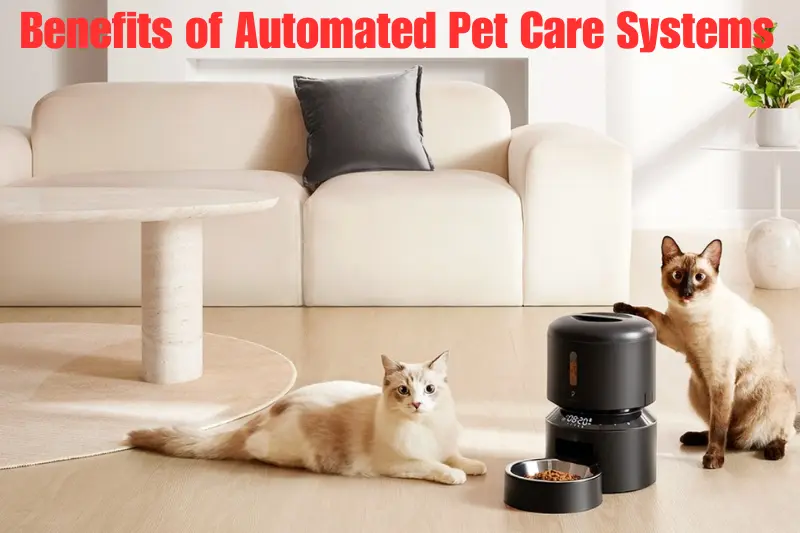
Convenience and Time-Saving
Automation reduces the time spent on repetitive tasks like feeding, watering, and cleaning, allowing owners to focus on quality interactions.
Consistency in Care
Pets thrive on routine. Automated systems deliver food, water, and exercise on precise schedules, which supports their physical and emotional well-being.
Improved Health and Early Detection
Monitoring technologies help detect health issues early, allowing prompt intervention and preventing complications.
Enhanced Well-being and Enrichment
Interactive toys and environmental controls reduce stress and promote natural behaviors, leading to happier pets.
Peace of Mind for Owners
Owners gain confidence that their pets are well cared for, even during busy days, travel, or emergencies.
Challenges and Considerations
Upfront and Maintenance Costs
High-quality automated pet care systems can be costly, and some require regular maintenance, like cleaning and replacing parts or batteries.
Dependence on Power and Connectivity
Most systems rely on electricity and Wi-Fi. Power outages or internet disruptions can interrupt care functions.
Need for Human Interaction
Automation should complement—not replace—human attention. Pets need love, companionship, and social interaction to thrive.
Technical Setup and Compatibility
Some devices require a learning curve to set up and may not be compatible with all pet types or multiple pet households without additional accessories.
Popular Automated Pet Care Products
- PetSafe Smart Feeders: Reliable for portion-controlled feeding with app scheduling.
- Litter-Robot: Highly rated self-cleaning litter boxes for cats.
- SureFeed Microchip Feeders: Uses pet microchips to dispense food only to the intended pet.
- Whistle Health Trackers: Wearable GPS and health monitors.
- Furbo Dog Camera: Allows owners to watch, talk, and toss treats remotely.
The Future of Automated Pet Care
Artificial Intelligence and Machine Learning
Future systems will learn pets’ routines and preferences, adapting feeding schedules, playtime, and environmental conditions dynamically.
Multi-Pet Management
Devices will better distinguish individual pets, enabling personalized care in multi-pet homes.
Enhanced Health Diagnostics
Integration with veterinary clinics for real-time health monitoring and telemedicine consultations will become common.
Sustainability
Eco-friendly materials, energy-efficient designs, and waste reduction technologies will shape the next generation of pet care systems.
Conclusion
Automated pet care systems are transforming pet ownership by providing smart, reliable, and convenient ways to care for pets. They help ensure consistent feeding, hydration, health monitoring, and enrichment, improving pets’ quality of life and easing the daily demands on owners. While technology cannot replace the bond between pet and owner, it acts as a powerful tool to support responsible and compassionate pet care.
If you want to explore automated systems for your pet, start by identifying your pet’s specific needs and researching devices that fit your lifestyle and budget. With the right tools, you can create a safer, healthier, and happier environment for your beloved companion.
FAQs
1. What is an automated pet care system?
An automated pet care system is a technology-driven setup designed to help manage various aspects of pet care—such as feeding, play, health monitoring, and environmental control—without constant human intervention. These systems often use smart devices, sensors, and AI to provide personalized and timely care for pets.
2. How do automated feeders work?
Automated feeders dispense food to pets at scheduled times or based on real-time data like pet activity and hunger levels. Advanced feeders may adjust portion sizes and feeding frequency using AI to maintain a pet’s optimal health and weight.
3. Can automated pet care systems handle multiple pets?
Yes! Many modern systems are designed for multi-pet homes. They use technologies like RFID chips or facial recognition to identify individual pets, ensuring personalized feeding, medication, and play without mix-ups or conflicts.
4. Are automated pet care systems safe for my pet?
When sourced from reputable brands and used as intended, automated pet care devices are generally safe. Many systems include safety features such as secure compartments, tamper-proof designs, and health monitoring alerts to ensure pet safety and well-being.
5. How do automated health monitoring systems work?
Wearable devices and smart collars monitor vital signs such as heart rate, temperature, and activity levels continuously. This data is analyzed to detect health abnormalities early and can be shared with veterinarians for remote consultation and timely medical intervention.

